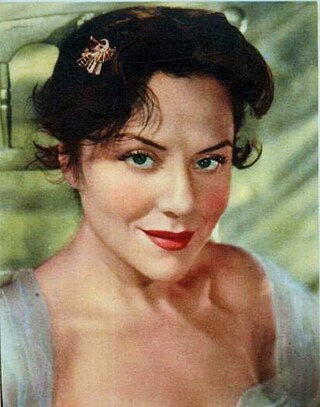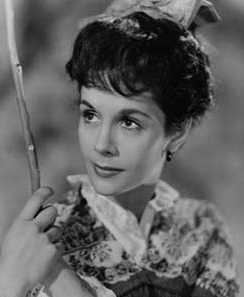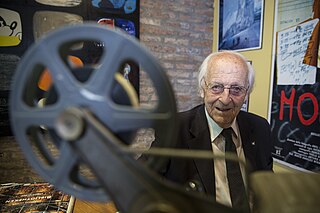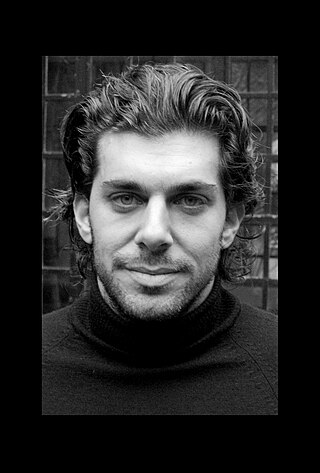
Cinema of Colombia refers to film productions made in Colombia, or considered Colombian for other reasons. Colombian cinema, like any national cinema, is a historical process with industrial and artistic aspects.

Colegio Nacional de Buenos Aires is a public high school in Buenos Aires, Argentina, affiliated to the University of Buenos Aires. In the tradition of the European gymnasium it provides a free education that includes classical languages such as Latin and Greek. The school is one of the most prestigious in Latin America. Its alumni include many personalities, including two Nobel laureates and four Presidents of Argentina.
The Mar del Plata International Film Festival is an international film festival that takes place every November in the city of Mar del Plata, Argentina. It is the only competitive feature festival recognized by the FIAPF in Latin America, and the oldest in this category in the Americas. The festival is organized by the National Institute of Cinema and Audiovisual Arts (INCAA).

Amelia Bence was an Argentine film actress and one of the divas of the Golden Age of Argentine Cinema (1940–1960).

Dark River is a 1952 Argentine drama film directed by Hugo del Carril, starring del Carril, Adriana Benetti and Raúl del Valle. It is based on a novel by Alfredo Varela. The storyline is about exploitation of peons, and the film has a populist message that ties in with the director's sympathy for Peronism. The film won the Silver Condor Award for Best Film.

Delia Amadora García Gerboles better known as Delia Garcés was an Argentine film actress of the Golden Age of Argentine Cinema (1940–1960). She made almost 30 appearances in film between 1937 and 1959 and acted on stage from 1936 to 1966. She won the Premios Sur Best Actress award three times from the Argentine Academy of Cinematography Arts and Sciences, as well as the Argentine Film Critics Association's Silver Condor Award for Best Actress, the Premios Leopold Torre Nilsson, Premio Pablo Podestá, and the inaugural ACE Platinum Lifetime Achievement Award from the Asociación de Cronistas del Espectáculo.

Laura Ana "Tita" Merello was an Argentine film actress, tango dancer and singer of the Golden Age of Argentine Cinema (1940–1960). In her six decades in Argentine entertainment, at the time of her death, she had filmed over thirty movies, premiered twenty plays, had nine television appearances, completed three radio series and had had countless appearances in print media. She was one of the singers who emerged in the 1920s along with Azucena Maizani, Libertad Lamarque, Ada Falcón, and Rosita Quiroga, who created the female voices of tango. She was primarily remembered for the songs "Se dice de mí" and "La milonga y yo".

Eduardo Montes-Bradley is a documentary filmmaker known for Evita, Rita Dove: An American Poet, and Harto The Borges. His most recent films are Black Fiddlers and Daniel Chester French: American Sculptor He’s currently working on The Italian Factor: The Piccirilli Story.

Zulema Esther González Borbón, better known as Zully Moreno, was an Argentine film actress of the Golden Age of Argentine Cinema (1940–1960). She appeared in more than 70 movies, earning best actress awards from the Argentine Academy of Motion Picture Arts and Sciences and the Spanish Cinema Writers Circle.

Alita Blanca Barchigia, better known as Alita Román, was an Argentine film actress of the Golden Age of Argentine Cinema (1940–1960).

Manuel Antín was an Argentine film director and screenwriter.

Marcelo Mosenson is the founder and executive director of the film production company Nomade Films.
The Argentine Academy of Cinematography Arts and Sciences was an industry association in Argentina founded in 1941. It was closed by the military junta in 1955.

His Best Student is a 1944 Argentine biographical drama film directed by Lucas Demare and starring Enrique Muiño and Ángel Magaña. It was released in Buenos Aires on 22 May 1944. The film won many awards, including the award for best film of the year.
Celina Murga is an Argentinian filmmaker, screenwriter, and producer. Celina's prevalence within the cinematic industry benefited heavily from her second directorial project Ana and the Others (2003), the film was so well received, it even compelled a certain iconic filmmaker into action. After a screening of Murga's film, American film director Martin Scorsese extended an offer to Murga for her to join him on the set of his current motion picture at the time Shutter Island (2010). However, the invitation for a burgeoning filmmaker to become an assistant within his production is not unprecedented, screenwriter Amy Holden Jones was the first to gain this type of access in 1976, on the set of Martin Scorsese's Taxi Driver.
The Sur Award for Best Actress, is an award given annually by the Argentine Academy of Cinematography Arts and Sciences to the best leading performance by a female actor.

Gloria Guzmán (1902–1979) was a Spanish-born Argentine vedette and actress who performed in the early Argentine theater.

Estudios San Miguel was an Argentine film studio that was active in the 1940s and early 1950s. It flourished during the golden age of Cinema of Argentina, and at its peak was one of the major studios in Buenos Aires. Genres ranged from musical comedy to costume drama and gaucho thriller. Films included La guerra gaucha, co-produced with Artistas Argentinos Asociados, and the comedy Juvenilia (1943), both of which won several major awards. Eva Duarte, soon to become the first lady of Argentina as Eva Perón, appeared in two of the studio's films in 1945. The studio became overextended financially and ceased production after 1952.

Gonzalo Calzada is an Argentine filmmaker and writer, best known for his directoral work on fantasy and horror films. His film Luisa was awarded the best "opera prima" at the 33rd Cairo International Film Festival in 2009. His film Resurrection achieved historic box office rankings for its genre in Argentina. Calzada's work is internationally recognized by film critics.

Alone Together is a 2023 Peruvian drama film written and directed by Carmen Rojas Gamarra in her directorial debut. Starring Tania Del Pilar as a shy, anxious and depressed thirty-year-old woman who searches for her place in the world with the help of her friend and her friend's boyfriend.
















